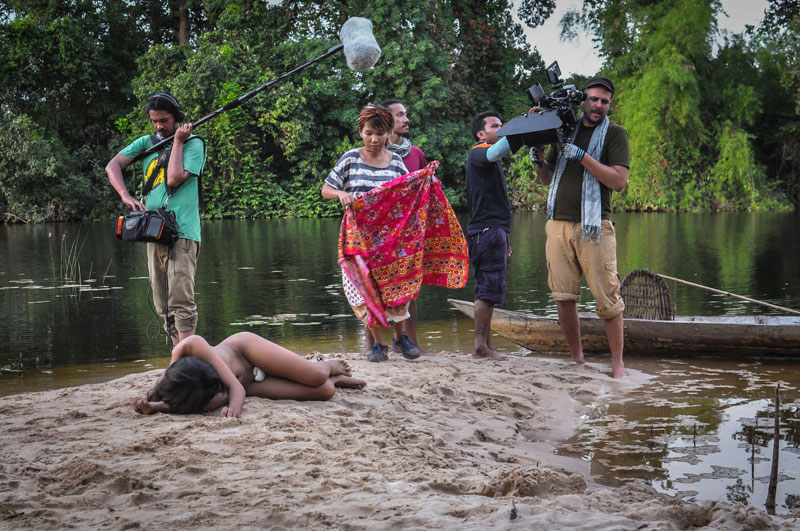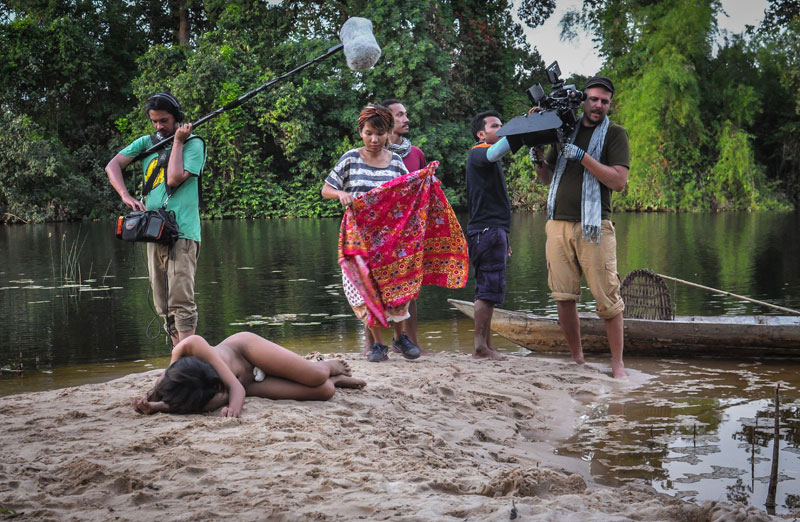KAMPOT PROVINCE – Italian filmmaker Jimmy Henderson, an unlikely pioneer of contemporary Khmer-language cinema, began filming here last week for his new movie, “The Uninvited,” an allegorical eco-drama set in Cambodia’s distant past.
The shoot will last 24 days—although if the first day was anything to go by, it will feel much longer. After filming an early morning scene deep in the forest, the sound and camera crews spent hours confined to a wooden raft floating on the Toek Chhou River near the village set—purpose built over the past month—about 7 km upstream from Kampot City.

Crouched over a top-of-the-line Red Dragon camera amid scattered water bottles and Royal D sachets, they shot take after take of a fisherman played by 70-year-old Eay Sarem. All afternoon, he paddled up and down the river without complaint as the scene was repeatedly interrupted by the sounds of motorbike engines, mobile-phone chatter and heavy machinery in the distance.
Sipping a beer back at the Haksoun Guesthouse in Kampot City—which will be home to more than 80 cast and crew members for the next few weeks—Mr. Henderson, 30, said the idea of luck as it is understood in Cambodia had planted the seed that became “The Uninvited.”
“I remember a news story a while back: These villagers found a huge python on a construction site close to where they lived and they took the python home overnight so they could return it to the forest the next day,” he said. “But that night, they all had dreams of being sick and poor so the following morning, they held a ceremony and began worshipping the snake, asking for forgiveness and good luck.”
“It felt like an old fairytale, yet it was a contemporary event,” said the Italian, whose first feature film, “Hanuman,” was released locally in March to positive reviews.
A contemporary exploitation flick, “Hanuman” also drew on folklore, its narrative based on the myth of the Hindu monkey god. On a tiny budget, Mr. Henderson painted a violent and surreal portrait of crime-ridden Phnom Penh.
Kith Thieng, the founder and chairman of local studio Rock Production, liked what he saw and decided to back the director’s next film. Although Mr. Henderson now has a much larger budget to work with—he declined to say how much larger—he was keen to keep the plot simple in order to delve deeper into the elemental nature of folklore in society.
“The Uninvited” tells the story of a remote village lorded over by a domineering commune chief, played by Prince Sisowath Siriwudd. He wields power through threats of violence as drought and other extreme weather conditions plague villagers due to a curse. When a mysterious woman—the “Uninvited” of the film’s title—appears out of nowhere, the fortunes of the villagers are altered, at first for better, later for worse.
“The python story led me to think about the idea of a film set in Cambodia’s past using local folklore to create a kind of fantasy, like a Brothers Grimm fairytale, to look at universal issues such as climate change, poverty and the abuse of power,” Mr. Henderson said.
But it’s not all serious. The Italian said his vision is as much Disney fairy tale as hard satire. The film’s main focus will be Cambodia itself, and with the goal of screening the movie internationally, he is eager to paint an authentic picture.
“I still want to be faithful to Cambodia,” he said. “I have made no concessions…and like on ‘Hanuman,’ every member of the cast is Cambodian and all but two of the crew.”
Before writing the script, Mr. Henderson did as much research as possible into Cambodian folklore, and the details of daily life in the distant past, such as what people wore and what they ate. But there are few studies and scant primary sources to shed a light on what he said was the most essential aspect of the movie: how people lived.
“Because there is very little to find on personal ways of living, I did interviews with older people, with the grandparents of crew members, and had lots of discussion about day-to-day village life when they were young, what people did in their spare time, sitting around in the village, what they talked about,” he said.
With the super-high-resolution 6K camera at his disposal, Mr. Henderson said he would attempt to rely on natural light as much as possible, also drawing on visual influences including Terrence Malick and Lars von Trier. He hopes to immerse the viewer in an idiosyncratic depiction of nature, which he promises will wreak havoc on the poor villagers in the film.
Movies made in Cambodia must be approved by the Ministry of Culture, and before going into production, Mr. Henderson was called before the ministry’s film censorship committee. They gave his film the green light, with a caveat.
“One character in the script, a Buddhist monk, they objected to something that the character did because a Buddhist monk could not act in such a way, and because his action was necessary to the plot, we had to redraw the character,” he said, explaining that to reveal the monk’s action would be to give away a key element of the plot.
There was another censorship challenge facing the script, though Mr. Henderson knew from the outset that he would have to find a way around it.
The mysterious “uninvited” woman, played by the actress Lida Duch, appears naked as she emerges from the forest, and when a fisherman later discovers her lying unconscious by the riverbank, she is also naked.
“You can’t show a naked Cambodian woman on screen in Cambodia,” Mr. Henderson said, as the answer to the puzzle took a seat next to him outside the hotel.
“A friend of a friend told me Jimmy needed a body double, so I went for casting and they said yes,” said Nita Quan, a 30-year-old transgender woman and first-time actress who is almost the exact same size and shape as Ms. Duch.
“Censoring female nudity is supposed to protect morals, but the people who make these rules are people in powerful positions, who impose these values on our society,” she said. “They won’t allow actresses naked on screen, they keep them traditional, to keep them pure, because they want them for themselves.”
Ms. Quan is not inclined to lend wider significance to her role in the film. But other gender issues may draw strong opinions, for in a sense the female body, in the form of the uninvited woman, becomes a canvas for the movie’s moral and environmental message as it becomes a victim of sexual violence.
Did the director have any reservations about using the female body as a symbolic means of critiquing past and present-day Cambodia and its patriarchal society?
“I think people will interpret the film differently,” he said. “But in crude terms, humans are constantly ‘raping’ nature: cutting trees, polluting rivers and destroying natural habitats. And now nature is starting to fight back. In ‘The Uninvited,’ I want to show if nature takes a human form, this is what it would be like.”




